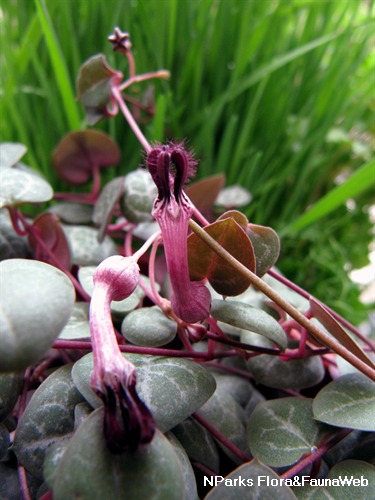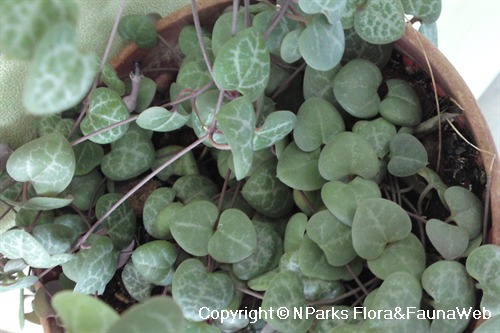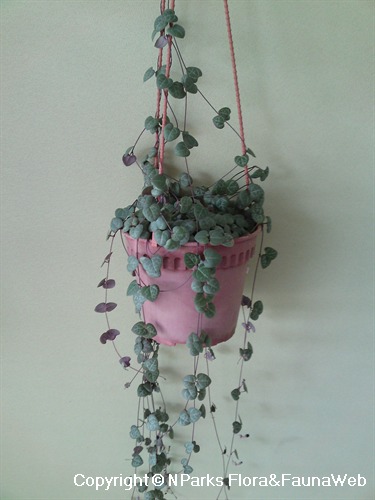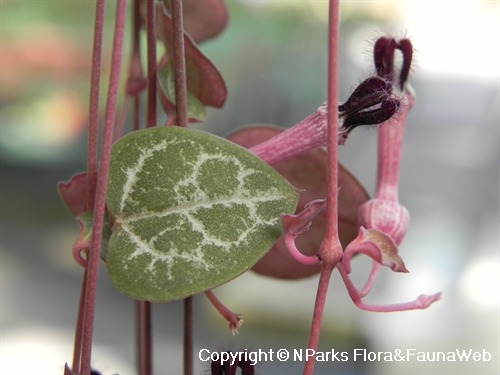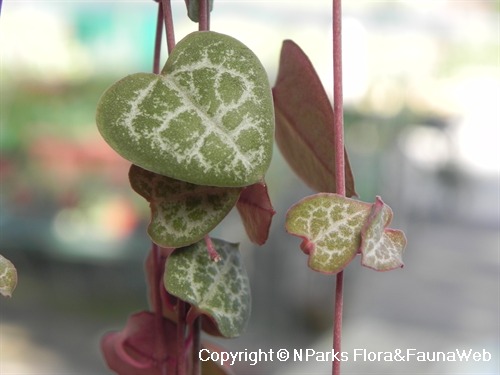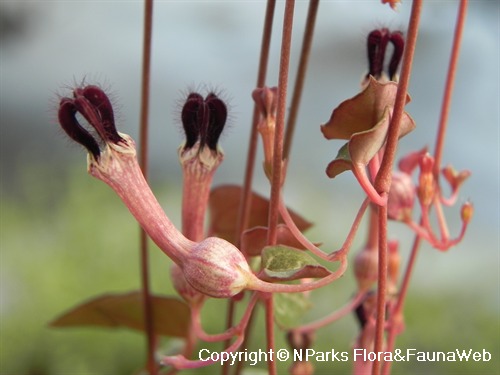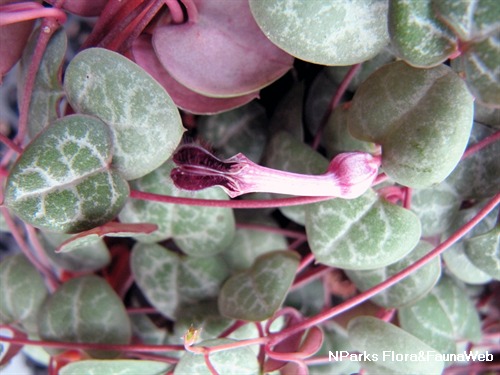
Back
Ceropegia linearis subsp. woodii
| Family Name: | Apocynaceae |
| Synonyms: | Ceropegia schoenlandii, Ceropegia barbertonensis, Ceropegia hastata, Ceropegia woodii |
| Common Name: | Rosary Vine, Sweetheart Vine, Hearts Entangled, Hearts on a String, String of Hearts, 吊灯花 |
Name
Classifications and Characteristics
| Plant Division | Angiosperms (Flowering Seed Plants) (Dicotyledon) |
|---|---|
| Plant Growth Form | Climber |
| Mode of Nutrition | Autotrophic |
| Maximum Height | 1.8 m to 2.4 m |
Biogeography
| Native Distribution | Southern Africa, Zimbabwe to E. Cape, Madagascar, Canary Islands |
|---|
Description and Ethnobotany
| Others - Plant Morphology | Growth Form: Succulent with trailing growth habit. Habitat: Dry environments. Stem: Stem light purple and glabrous. It is herbaceous and thin. Tubers are produced at the nodes (the portion of stem directly attached to leaves). Foliage: Leaves small (1.3 cm wide, 2 cm long) and cordate (shaped like hearts). The top is green with white or light purple markings, while the bottom is pink or light purple. Flowers: Flowers are vertically oriented, tubular and pink with a small balloon-like base (2 cm long). The lobes at the apex are dark purple with purple hairs. They form arch-like structures over the opening of the flower. Fruits: Fruits are follicles, a type of dry fruit produced from one ovary. Landscaping: This species may be used as a focal plant to attract interest, because the flowers have a unique shape. It is ideal for hanging baskets that could be hung from tree branches or above a patio. Alternatively, consider potting the plant and training it to grow along a small, circular trellis to produce a decorative hoop of leaves. This species will be attractive hung against a wall like a curtain or from the top of a pergola (a type of trellis with vertical posts that support an open set of horizontal rafters). Cultivation: This species is easy-to-grow. It will grow best under full sun, but it can also be grown under semi-shade. This species is prone to basal rot when it is watered too much or the soil becomes waterlogged. Allow the soil to dry before re-watering. For indoor plants, use a soilless or cactus mix with good drainage and feed on a monthly basis with a dilute solution of low nitrogen liquid fertilizer. Plants should be re-potted every 3 years. This species is usually resistant to pests, but it may be attacked by mealy bugs, whiteflies, spider mites and aphids. Propagation: Propagate by division or stem cuttings. For stem cuttings, remove a piece from the tip that contains 2 - 3 nodes by cutting the stem just beneath a node. You can also plant the tubers produced at the nodes of the stem. Etymology: The genus "Ceropegia" is derived from the Greek words "keros" meaning wax and "pege" meaning fountain. These terms refer to the flowers which look waxy and are shaped like fountains. |
|---|
Landscaping Features
| Desirable Plant Features | Ornamental Foliage, Ornamental Flowers |
|---|---|
| Landscape Uses | Suitable for Hanging Baskets, Interiorscape/ Indoor Plant, Container Planting |
Plant Care and Propagation
| Light Preference | Full Sun |
|---|---|
| Water Preference | Little Water |
| Rootzone Tolerance | Easy to Grow, Drought Tolerant, Well-Drained Soils |
| Maintenance Requirements | Low |
| Fertilizing | For indoor plants, feed on a monthly basis with a dilute solution of low nitrogen liquid fertilizer. |
| Diseases | mealy bugs, whiteflies, spider mites and aphids |
| Propagation Method | Stem Cutting, Division |
Foliar
| Mature Foliage Colour(s) | Cream / Off-White, Green |
|---|---|
| Mature Foliage Texture(s) | Smooth, Thick |
| Foliar Type | Simple / Unifoliate |
| Foliar Arrangement Along Stem | Opposite |
| Foliar Shape(s) | Non-Palm Foliage (Cordate) |
| Foliar Venation | Pinnate / Net |
| Foliar Margin | Entire |
| Foliar Apex - Tip | Caudate |
| Foliar Base | Cordate |
| Typical Foliar Area | Microphyll ( 2.25cm2 - 20.25 cm2 ) |
Non - Foliar and Storage
| Specialised Storage Organ(s) | Aboveground |
|---|
Floral (Angiosperm)
| Flower Colour(s) | Purple |
|---|
Image Repository
Others
| Master ID | 29734 |
|---|---|
| Species ID | 4043 |
| Flora Disclaimer | The information in this website has been compiled from reliable sources, such as reference works on medicinal plants. It is not a substitute for medical advice or treatment and NParks does not purport to provide any medical advice. Readers should always consult his/her physician before using or consuming a plant for medicinal purposes. |

